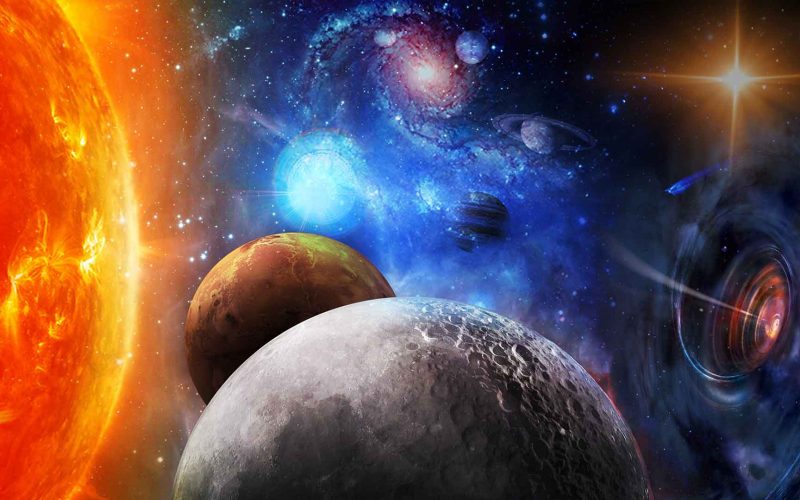Gravitational physics is a branch of physics that explores the fundamental forces governing the interactions between massive objects in the universe. Since ancient times, humans have been fascinated by the force of gravity, which governs the motion of planets, stars, and galaxies. The study of gravitational physics seeks to unravel the mysteries of gravity and its effects on the cosmos.
Understanding Gravitational Forces
One of the foundational principles of gravitational physics is Newton’s law of universal gravitation, formulated by Sir Isaac Newton in the 17th century. This law states that every mass attracts every other mass with a force proportional to the product of their masses and inversely proportional to the square of the distance between them. Newton’s law provided a framework for understanding the motion of celestial bodies and laid the groundwork for centuries of scientific inquiry into gravity.
In the early 20th century, Albert Einstein revolutionized our understanding of gravity with his theory of general relativity. According to Einstein’s theory, gravity is not just a force between objects, but rather a curvature of spacetime caused by the presence of mass and energy. General relativity has been validated through numerous experiments and observations, confirming its accuracy in describing the behavior of gravitational forces on both cosmic and microscopic scales.
Gravitational Waves: A Breakthrough Discovery
One of the most significant developments in gravitational physics in recent years has been the detection of gravitational waves. Predicted by Einstein’s theory of general relativity, gravitational waves are ripples in spacetime caused by the acceleration of massive objects, such as colliding black holes or neutron stars. In 2015, the Laser Interferometer Gravitational-Wave Observatory (LIGO) made history by directly detecting gravitational waves for the first time, opening a new window onto the universe and providing a wealth of information about cataclysmic events in the cosmos.
The detection of gravitational waves has profound implications for our understanding of the universe, allowing scientists to study phenomena that were previously inaccessible. By observing the properties of gravitational waves, researchers can probe the nature of black holes, neutron stars, and other extreme objects, shedding light on their formation, evolution, and behavior.
Black Holes: Mysterious Entities of Gravitational Pull

Black holes are perhaps the most enigmatic objects in the universe, possessing gravitational fields so strong that nothing, not even light, can escape their grasp. According to general relativity, black holes form when massive stars collapse under their own gravity at the end of their life cycles, compressing matter into an infinitely dense singularity surrounded by an event horizon.
Despite their invisibility, black holes can be indirectly detected through their gravitational influence on nearby matter. Observations of stars orbiting around invisible companions and the detection of gravitational waves from black hole mergers provide compelling evidence for the existence of these cosmic behemoths.
Gravitational Lensing: Unveiling the Secrets of the Universe
Gravitational lensing is another phenomenon predicted by general relativity, in which the gravitational field of a massive object bends the path of light rays passing nearby. This effect can produce distorted or magnified images of distant objects, allowing astronomers to study galaxies, quasars, and other celestial bodies that would otherwise be too faint or distant to observe.
The study of gravitational lensing has led to numerous discoveries in astrophysics, including the detection of exoplanets, the mapping of dark matter distributions in galaxy clusters, and the measurement of the expansion rate of the universe. Gravitational lensing has also been used to test the predictions of general relativity and alternative theories of gravity, providing valuable insights into the nature of spacetime.
Dark Matter and Dark Energy: The Invisible Forces Shaping the Cosmos
In addition to visible matter such as stars and galaxies, the universe contains vast amounts of invisible matter and energy that exert gravitational effects on cosmic scales. Dark matter is believed to make up approximately 27% of the total mass-energy content of the universe, yet its nature remains a mystery. Unlike ordinary matter, dark matter does not emit, absorb, or reflect light, making it extremely difficult to detect directly.
Dark energy, on the other hand, is a mysterious force that appears to be driving the accelerated expansion of the universe. First inferred from observations of distant supernovae in the late 1990s, dark energy constitutes about 68% of the total energy density of the universe. Its origin and properties are still not well understood, posing one of the greatest challenges in modern cosmology.
Current Frontiers in Gravitational Physics Research
Despite centuries of study, many questions about gravity remain unanswered, particularly at the quantum level. The quest for a unified theory of gravity that reconciles general relativity with quantum mechanics is one of the most active areas of research in theoretical physics. Various approaches, such as string theory, loop quantum gravity, and holographic duality, offer promising avenues for understanding gravity on fundamental scales.
Experimental efforts to test the predictions of gravitational physics are also advancing rapidly, thanks to technological innovations and international collaborations. Projects such as the European Space Agency’s Laser Interferometer Space Antenna (LISA) and the Square Kilometer Array (SKA) promise to revolutionize our understanding of gravity and cosmology in the coming decades.
Practical Applications of Gravitational Physics
Beyond its theoretical significance, gravitational physics has numerous practical applications in modern technology and everyday life. Satellite-based navigation systems, such as the Global Positioning System (GPS), rely on precise measurements of gravitational time dilation to determine the positions of satellites and receivers on Earth’s surface. Similarly, gravitational physics plays a crucial role in the design and operation of spacecraft, ensuring accurate trajectories for missions to other planets and celestial bodies.
In the field of cosmology, gravitational physics informs our understanding of the origin, evolution, and fate of the universe. By studying the distribution of galaxies, the cosmic microwave background radiation, and the large-scale structure of the cosmos, astronomers can test theoretical models of cosmic evolution and gain insights into the fundamental nature of reality.
Challenges and Unanswered Questions in Gravitational Physics
Despite the remarkable progress made in gravitational physics, several key challenges remain unresolved. One of the most pressing issues is the development of a quantum theory of gravity that can describe the behavior of gravity at the smallest scales. While general relativity provides an accurate description of gravity on cosmic scales, it breaks down in the extreme conditions of black holes and the early universe, where quantum effects become significant.
Understanding the nature of singularities, such as those that occur at the centers of black holes and the Big Bang, is another major puzzle in gravitational physics. Singularities represent points of infinite density and curvature where the laws of physics as we know them break down, posing profound questions about the nature of spacetime and the fundamental structure of the universe.
Educational and Career Opportunities in Gravitational Physics
For aspiring physicists and researchers, gravitational physics offers a wealth of educational and career opportunities. Academic programs in theoretical and experimental physics provide training in advanced mathematical techniques, computational modeling, and laboratory experimentation, preparing students for careers in academia, industry, and government.
Research institutions and observatories around the world conduct cutting-edge research in gravitational physics, offering students and postdoctoral researchers the chance to participate in groundbreaking experiments and observations. Collaborative projects such as the LIGO Scientific Collaboration and the Event Horizon Telescope bring together scientists from diverse backgrounds to tackle some of the most challenging questions in astrophysics and cosmology.
Public Interest and Pop Culture References
Gravitational physics has captured the imagination of the public and has been a recurring theme in popular culture, from science fiction novels and movies to television shows and video games. Concepts such as black holes, wormholes, and time dilation have become familiar tropes in popular media, inspiring awe and curiosity about the mysteries of the universe.
While many portrayals of gravitational physics in popular culture take artistic liberties for dramatic effect, some works strive for scientific accuracy and realism. Films such as “Interstellar” and “Gravity” have garnered praise for their attention to scientific detail and use of visual effects to depict the phenomena of gravity in space.
Future Prospects: What Lies Ahead for Gravitational Physics?

Looking ahead, the future of gravitational physics promises continued discovery and innovation as scientists push the boundaries of human knowledge. Advancements in observational techniques, computational methods, and theoretical frameworks will enable researchers to explore new realms of the cosmos and test the limits of our understanding of gravity.
The upcoming generation of gravitational wave detectors, such as LISA and third-generation ground-based detectors, will open new windows onto the universe, allowing scientists to study black holes, neutron stars, and other exotic objects with unprecedented sensitivity and resolution. These observatories will provide valuable data for testing alternative theories of gravity and probing the nature of spacetime on cosmic scales.
Collaborative Efforts and International Partnerships
Collaboration and cooperation are essential for advancing the field of gravitational physics and addressing some of its most pressing challenges. International partnerships, such as those between the United States, Europe, and Asia, bring together scientists from diverse backgrounds and disciplines to tackle complex problems that require global collaboration.
Projects such as the Large Hadron Collider (LHC) at CERN and the International Space Station (ISS) exemplify the spirit of international cooperation in science, fostering cross-cultural exchange and mutual understanding. By sharing data, resources, and expertise, researchers can accelerate progress and achieve breakthroughs that would be impossible for any single institution or country to accomplish alone.
Ethical Considerations and Societal Impacts
As with any scientific endeavor, the study of gravitational physics raises important ethical considerations and societal impacts that must be carefully considered. Research involving black holes and other extreme phenomena raises questions about the potential risks and benefits of exploring the unknown. Ethical guidelines and protocols are needed to ensure that scientific research is conducted responsibly and with proper regard for safety and ethical concerns.
At the same time, the societal impacts of gravitational physics research can be far-reaching, inspiring curiosity, wonder, and a sense of awe about the universe and our place in it. By fostering public engagement and education, scientists can help cultivate a deeper appreciation for the beauty and complexity of the cosmos, inspiring future generations of researchers and explorers to continue pushing the boundaries of human knowledge.
Conclusion
In conclusion, gravitational physics represents one of the most profound and far-reaching areas of scientific inquiry, exploring the fundamental forces that shape the universe and govern the motion of celestial bodies. From the discovery of gravitational waves to the study of black holes, dark matter, and dark energy, gravitational physics offers a glimpse into the deepest mysteries of the cosmos. By continuing to push the boundaries of human knowledge through observation, experimentation, and theoretical modeling, scientists are unraveling the secrets of gravity and unlocking new insights into the nature of reality.
FAQs
What is the significance of gravitational waves?
Gravitational waves provide a new way of observing the universe, allowing scientists to study phenomena such as black holes and neutron stars that cannot be observed using traditional telescopes.
How do gravitational waves differ from electromagnetic waves?
Gravitational waves are ripples in spacetime caused by the acceleration of massive objects, whereas electromagnetic waves are disturbances in electric and magnetic fields that propagate through space.
What are some practical applications of gravitational physics?
Gravitational physics has applications in satellite navigation, spacecraft trajectory planning, and cosmological simulations, among others.
What are the current frontiers of research in gravitational physics?
Some of the current frontiers of research include the search for a quantum theory of gravity, the study of black hole mergers, and the exploration of the early universe.
How can I get involved in gravitational physics research?
Students interested in gravitational physics can pursue degrees in physics, astronomy, or related fields and seek out research opportunities at universities and research institutions. Collaborative projects such as LIGO and LISA offer opportunities for students and postdoctoral researchers to contribute to cutting-edge research in the field.










